👉Jun Answers and Trivia
👉May Answers and Trivia
👉April Answers and Trivia
👉March Answers and Trivia
👉February Answers and Trivia
👉January Answers and Trivia
XENEA Wallet features a Daily Quiz that enhances user engagement while offering a fun and gamified way to learn about Web3 and the Xenea ecosystem.
Although many kind individuals are sharing answers on X (formerly Twitter), it feels like the quiz is turning into a game of simply picking the right answer without understanding the questions. To address this, this article will provide not only the answers to XENEA Wallet’s Daily Quiz but also the reasoning behind them and additional insights. By leveraging XENEA Wallet NAVI (ChatGPT), we aim to make the experience more informative and meaningful.
It takes less than a minute, so bookmark this page and check back daily! 😊
Start Your Journey with XENEA Wallet Today!
XENEA Wallet is an innovative app that makes exploring the world of Web3 both fun and rewarding! Complete simple missions, claim daily bonuses, and earn rewards while learning about the future of digital technology.
With cutting-edge security and unparalleled convenience, XENEA Wallet offers you the chance to participate in future airdrops and mining opportunities. Simply download the app to begin your new digital experience!
New users can start with 1,000 gems by signing up with the invite code below!
1️⃣ Download the app
2️⃣ Enter the invite code: h3dYzHejPI
3️⃣ Sign up with your Google or Apple account
Enjoy the exciting world of XENEA Wallet!
Please refer to the following page for information on how to earn Gems.
How many days does it take to earn 10,000 gems and start automatic mining with the XENEA Wallet?
Daily Quiz on JULY 31
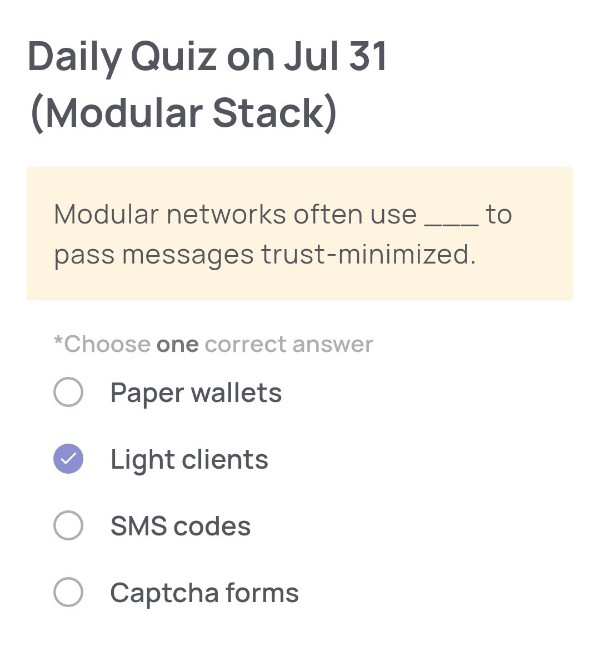 🟢 Quiz Questions:
🟢 Quiz Questions:
Modular networks often use _ to pass messages trust-minimized.
🟢 Choose one correct answer:
・Paper wallets
・Light clients
・SMS codes
・Captcha forms
🟢 Answer:
Light clients
🟢 Reason for choosing this answer:
Modular networks such as Celestia or Ethereum 2.0 often use light clients to pass messages in a trust-minimized way. Light clients allow users or chains to verify certain states (like headers or finality) without downloading the full blockchain, relying instead on succinct proofs like Merkle proofs or SNARKs. This enables interoperability and communication across chains with minimal trust assumptions, making them an essential part of the modular architecture.
🟢 Trivia:
A well-known example of a light client in practice is Ethereum’s “Beacon light client,” which enables other blockchains or applications to verify Ethereum consensus with only header data. This is crucial for bridges or rollups that want to operate securely without relying on centralized oracles.
Daily Quiz on JULY 30
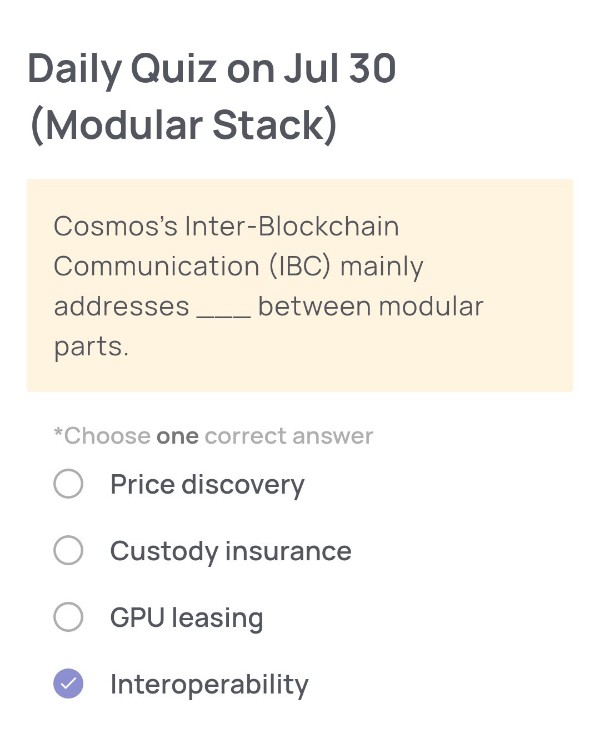
🟢Quiz Questions:
Cosmos’s Inter-Blockchain Communication (IBC) mainly addresses between modular parts.
🟢Choose one correct answer:
・Price discovery
・Custody insurance
・GPU leasing
・Interoperability
🟢Answer:
Interoperability
🟢Reason for choosing this answer:
Inter-Blockchain Communication (IBC) is a protocol developed by the Cosmos ecosystem to enable secure and trustless communication between different blockchains. Its core purpose is to achieve interoperability—the ability of multiple independent blockchain networks to communicate and exchange data or assets with each other. IBC allows modular parts (such as separate chains with specific functions) to work together seamlessly, which is crucial in the modular blockchain architecture Cosmos promotes.
🟢Trivia:
The IBC protocol is a cornerstone of Cosmos’s vision of the “Internet of Blockchains.” It allows for applications like cross-chain token transfers and data sharing without relying on a centralized exchange or bridge. For example, tokens on the Cosmos Hub can be transferred to the Osmosis chain using IBC, enabling users to engage in DeFi across chains.
Daily Quiz on JULY 29
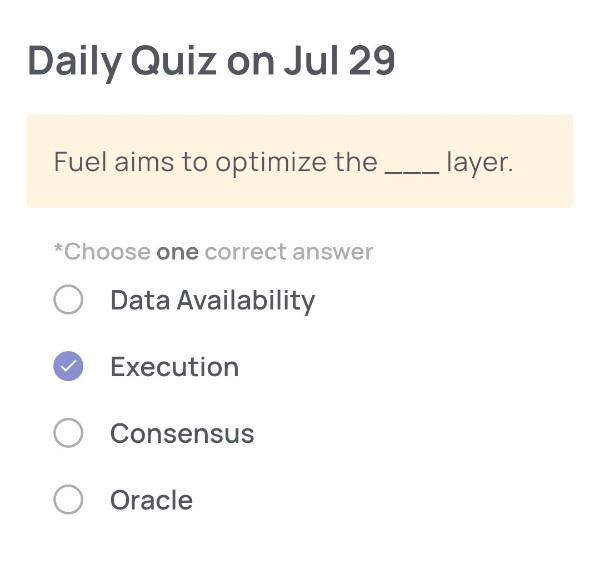
🟢Quiz Questions:
Fuel aims to optimize the layer.
🟢Choose one correct answer:
・Data Availability
・Execution
・Consensus
・Oracle
🟢Answer:
Execution
🟢Reason for choosing this answer:
Fuel is a modular execution layer specifically designed to optimize the execution component of the blockchain stack. Unlike monolithic chains that bundle execution, consensus, and data availability together, Fuel focuses on improving execution scalability and efficiency by decoupling it from the other layers. This separation allows for parallel transaction processing and better resource allocation, resulting in higher throughput and reduced bottlenecks.
🟢Trivia:
Fuel implements an architecture known as the FuelVM, a specialized virtual machine that supports parallel transaction execution. This is a significant advancement over traditional EVM-based chains, which typically process transactions sequentially. Fuel’s approach is part of a broader trend in blockchain infrastructure toward modular design, allowing different components (like Celestia for data availability) to specialize and interoperate for greater scalability.
Daily Quiz on JULY 28
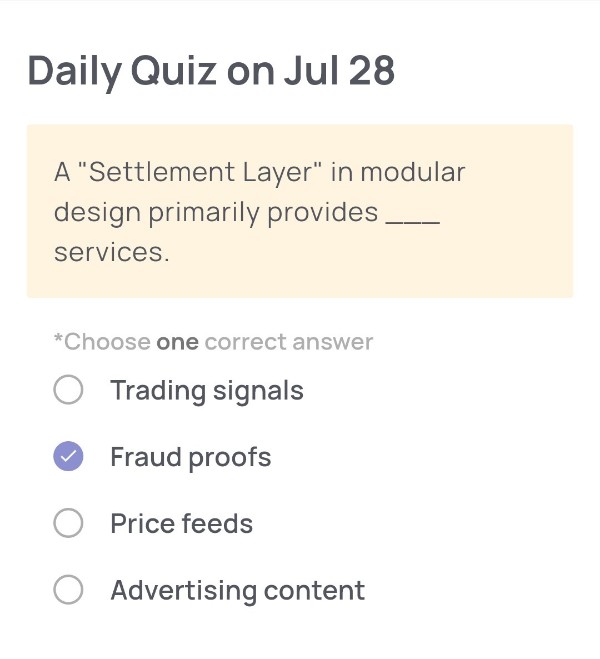
🟢Quiz Questions:
A “Settlement Layer” in modular design primarily provides services.
🟢Choose one correct answer:
・Trading signals
・Fraud proofs
・Price feeds
・Advertising content
🟢Answer:
Fraud proofs
🟢Reason for choosing this answer:
In a modular blockchain architecture, the “Settlement Layer” is responsible for finalizing and verifying the validity of transactions that occur on execution layers. It ensures that only correct and legitimate transactions are finalized on the chain. One of its primary responsibilities includes validating “fraud proofs” submitted from execution layers to challenge invalid state transitions. This helps secure the network by detecting and rejecting incorrect data before it is finalized.
🟢Trivia:
The modular blockchain model splits the responsibilities of a traditional monolithic blockchain (like Bitcoin or Ethereum) into separate layers:
- Execution Layer: Handles transaction execution and state updates
- Settlement Layer: Validates and finalizes blocks, and processes fraud proofs
- Data Availability Layer: Ensures transaction data is accessible to all participants
Ethereum 2.0 and newer blockchain projects like Celestia and Fuel Network adopt this design to enhance scalability, security, and efficiency.
Daily Quiz on JULY 27
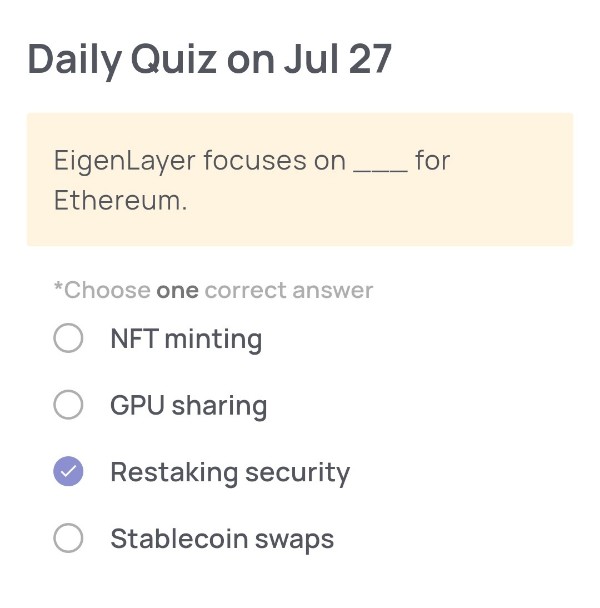
🟢Quiz Questions:
EigenLayer focuses on Ethereum. for
🟢Choose one correct answer:
・NFT minting
・GPU sharing
・Restaking security
・Stablecoin swaps
🟢Answer:
Restaking security
🟢Reason for choosing this answer:
EigenLayer is an Ethereum-based protocol that introduces the concept of “restaking.” It allows users to reuse (or “restake”) their staked ETH or liquid staking tokens to secure other applications and services built on Ethereum. This significantly enhances network security and decentralization by enabling shared security across multiple projects without requiring additional native tokens.
🟢Trivia:
EigenLayer’s restaking model opens up a new category of decentralized services known as “Actively Validated Services” (AVSs). These services—such as oracles, bridges, and rollups—can rely on Ethereum’s economic security through restaked assets, rather than building their own validator networks. This is viewed as a powerful innovation to scale and secure the Ethereum ecosystem.
Daily Quiz on JULY 26
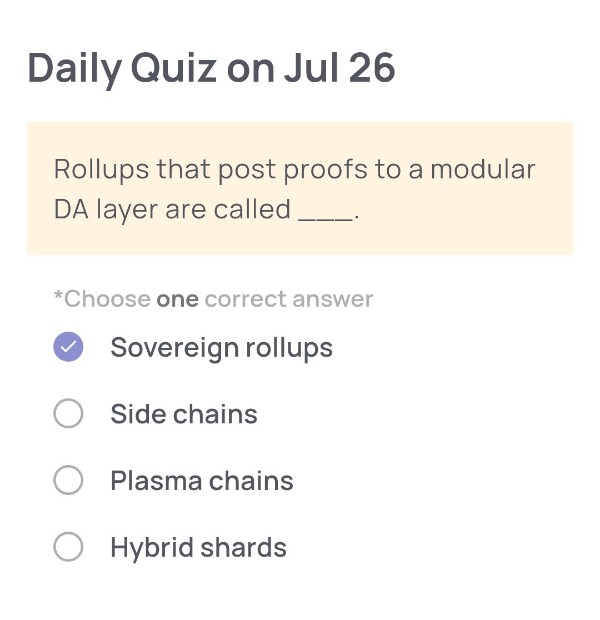
🟢Quiz Questions:
Rollups that post proofs to a modular DA layer are called_
🟢Choose one correct answer:
・Sovereign rollups
・Side chains
・Plasma chains
・Hybrid shards
🟢Answer:
Sovereign rollups
🟢Reason for choosing this answer:
Sovereign rollups are a type of rollup that rely on a modular data availability (DA) layer rather than posting data to a monolithic base layer like Ethereum. They handle execution independently but publish proofs and/or data to a separate modular DA layer, such as Celestia. This makes them distinct from traditional rollups that post to Ethereum, and allows them to maintain sovereignty over their execution logic and upgrades.
🟢Trivia:
Sovereign rollups are often paired with modular blockchain architectures. They do not depend on a settlement layer for security but instead use fraud or validity proofs and rely on their own consensus rules. Celestia is a leading example of a modular DA layer aiming to support these sovereign rollups, enabling more scalable and customizable blockchain solutions.
Daily Quiz on JULY 25
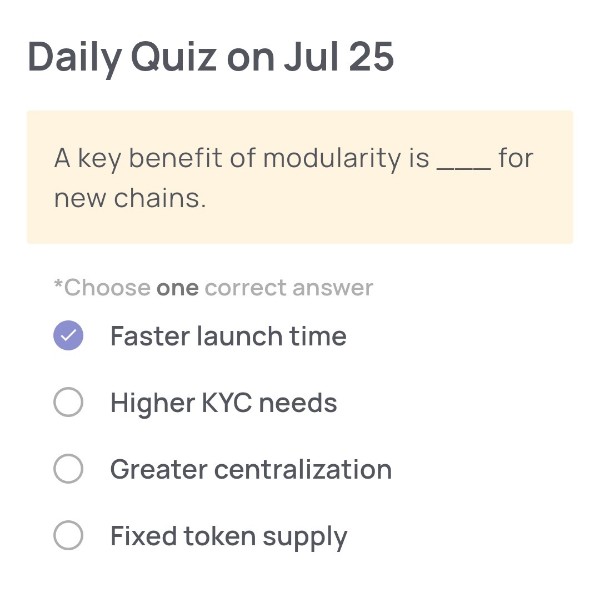
🟢Quiz Questions:
A key benefit of modularity is _ for new chains.
🟢Choose one correct answer:
・Faster launch time
・Higher KYC needs
・Greater centralization
・Fixed token supply
🟢Answer:
Faster launch time
🟢Reason for choosing this answer:
Modularity in blockchain architecture refers to designing systems where components can be easily added, replaced, or upgraded. This flexibility significantly reduces the time required to develop and deploy new chains because developers can reuse existing modules without building everything from scratch. In contrast, the other options—higher KYC needs, greater centralization, and fixed token supply—are not inherent benefits of modularity and could even contradict the decentralized ethos that modular systems typically aim to uphold.
🟢Trivia:
One prominent example of modular blockchain design is Ethereum 2.0, which adopts a modular architecture with components like the Beacon Chain, shard chains, and the Ethereum Virtual Machine (EVM). This design allows for scalability and adaptability over time, enabling the ecosystem to evolve more efficiently.
Daily Quiz on JULY 24
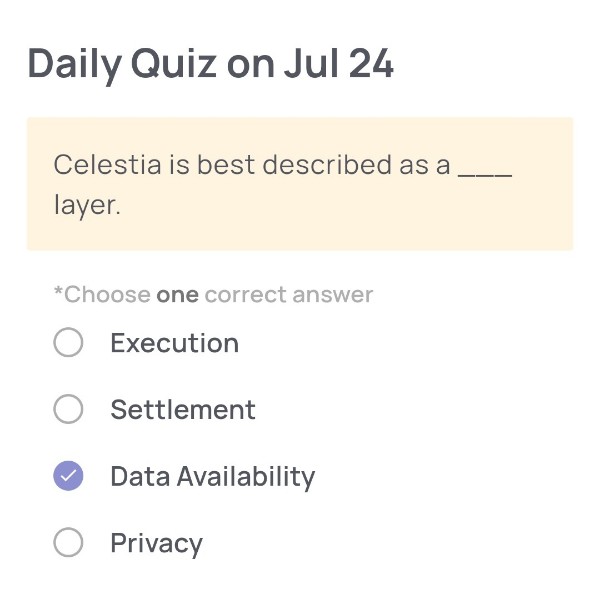
🟢Quiz Questions:
Celestia is best described as a layer.
🟢Choose one correct answer:
・Execution
・Settlement
・Data Availability
・Privacy
🟢Answer:
Data Availability
🟢Reason for choosing this answer:
Celestia is specifically designed as a modular blockchain that focuses solely on Data Availability (DA). It provides a scalable and decentralized layer where other blockchains (especially rollups) can publish their transaction data without relying on a monolithic architecture. This design allows execution and settlement to happen elsewhere (e.g., on rollups or other chains), while Celestia ensures the data is available and verifiable by all participants.
🟢Trivia:
Celestia uses Data Availability Sampling (DAS) to let light clients efficiently verify that data is available without downloading the entire dataset. This is a major innovation that enhances scalability and decentralization, as it allows more participants to validate the network with minimal hardware requirements.
Daily Quiz on JULY 23
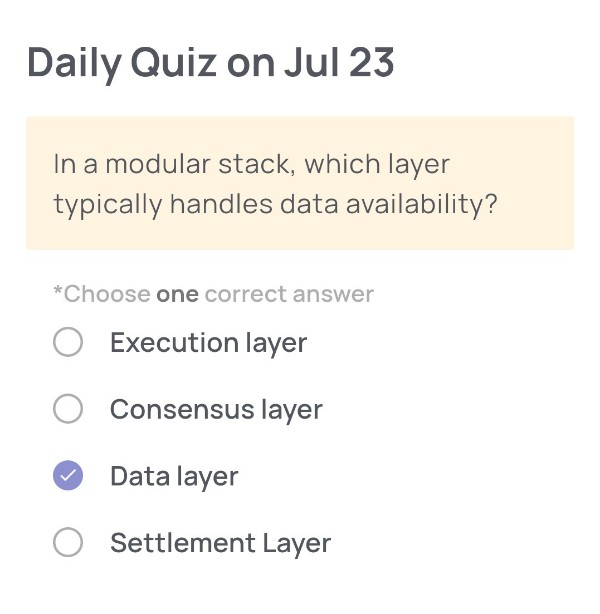
🟢Quiz Questions:
In a modular stack, which layer typically handles data availability?
🟢Choose one correct answer:
・Execution layer
・Consensus layer
・Data layer
・Settlement Layer
🟢Answer:
Data layer
🟢Reason for choosing this answer:
In a modular blockchain architecture, the “data layer” is primarily responsible for ensuring data availability. This means it handles the storage and accessibility of all the data necessary for verifying the state transitions of the blockchain. Without reliable data availability, other layers such as execution and consensus cannot function properly, as they rely on this data to validate transactions and maintain consistency.
🟢Trivia:
Data availability is a major focus in Layer 2 scaling solutions like Celestia and EigenDA. These protocols separate data storage from execution and consensus, allowing blockchains to scale efficiently without compromising security. This modular approach enhances decentralization and enables developers to build customized blockchain stacks.
Daily Quiz on JULY 22
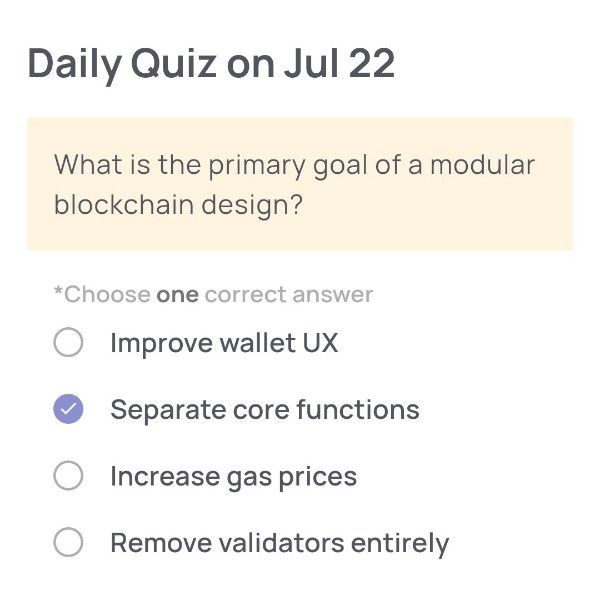
🟢Quiz Questions:
What is the primary goal of a modular blockchain design?
🟢Choose one correct answer:
・Improve wallet UX
・Separate core functions
・Increase gas prices
・Remove validators entirely
🟢Answer:
Separate core functions
🟢Reason for choosing this answer:
The primary goal of a modular blockchain design is to separate core functions—such as execution, consensus, and data availability—into distinct layers or modules. This decoupling allows for greater flexibility, scalability, and efficiency because each module can evolve independently and be optimized for its specific role. This contrasts with monolithic blockchains, where all components are tightly integrated, making upgrades and scaling more difficult.
🟢Trivia:
One notable implementation of modular architecture is Ethereum 2.0, which is moving toward separating execution and consensus through rollups and the beacon chain. This architecture enables specialized chains (like “data availability layers” or “execution environments”) to coexist and interoperate, leading to a more scalable and robust blockchain ecosystem.
Daily Quiz on JULY 21
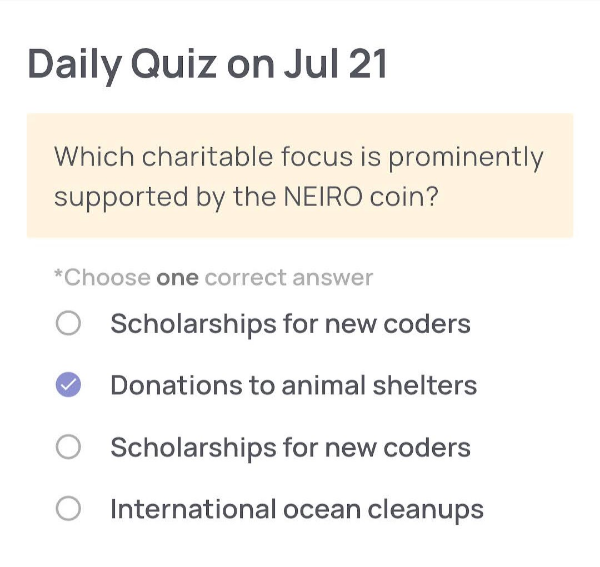
🟢Quiz Questions:
Which charitable focus is prominently supported by the NEIRO coin?
🟢Choose one correct answer:
・Scholarships for new coders
・Donations to animal shelters
・Scholarships for new coders
・International ocean cleanups
🟢Answer:
Donations to animal shelters
🟢Reason for choosing this answer:
NEIRO coin prominently supports charitable causes, with a particular emphasis on helping animal shelters. This initiative reflects NEIRO’s mission to merge blockchain innovation with real-world social impact. By directing a portion of its ecosystem toward supporting animal welfare, NEIRO coin creates tangible benefits beyond the digital realm and aligns with communities that value compassion and care for animals.
🟢Trivia:
Charitable blockchain projects like NEIRO are part of a growing movement known as “Crypto Philanthropy.” These projects use transparency and traceability features of blockchain to ensure donations are verifiable and go directly to causes such as animal welfare, disaster relief, or education. NEIRO’s support for animal shelters sets it apart by directly integrating donations into its tokenomics and community engagement strategies.
Daily Quiz on JULY 20
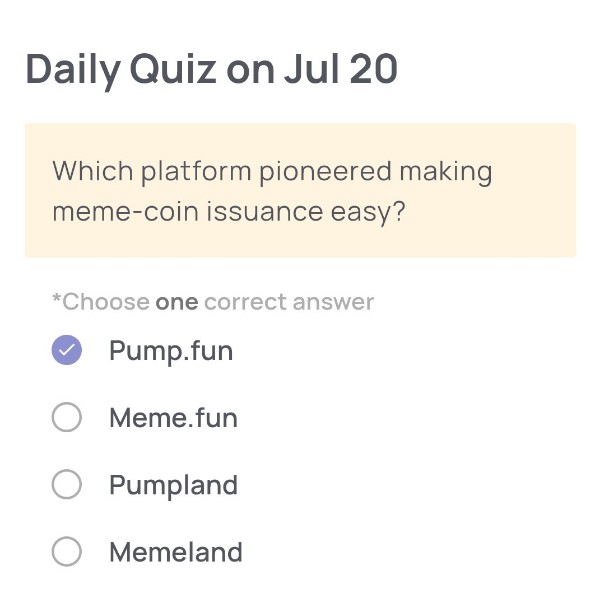
🟢Quiz Questions:
Which platform pioneered making meme-coin issuance easy?
🟢Choose one correct answer:
・Pump.fun
・Meme.fun
・Pumpland
・Memeland
🟢Answer:
Pump.fun
🟢Reason for choosing this answer:
Pump.fun is widely recognized as the platform that made launching meme-coins extremely accessible by allowing users to create and trade tokens with minimal effort, directly on the Solana blockchain. It provided a simple UI and automatic liquidity creation, leading to a surge in meme-coin popularity and activity. No coding skills were required, significantly lowering the barrier to entry.
🟢Trivia:
Pump.fun sparked a major trend on Solana in early 2024, where thousands of new tokens—often humorous or community-driven—were created daily. It contributed significantly to Solana’s transaction volume during that period and inspired similar platforms to emerge on other chains.
Daily Quiz on JULY 19
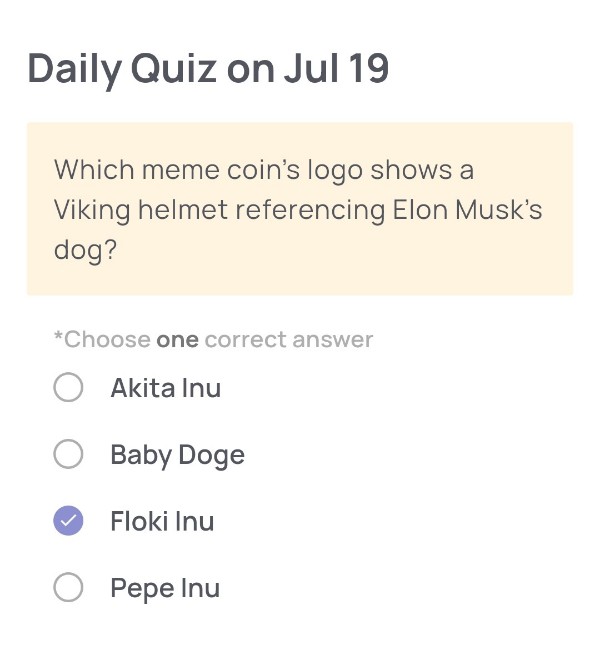
🟢Quiz Questions:
Which meme coin’s logo shows a Viking helmet referencing Elon Musk’s dog?
🟢Choose one correct answer:
・Akita Inu
・Baby Doge
・Floki Inu
・Pepe Inu
🟢Answer:
Floki Inu
🟢Reason for choosing this answer:
Floki Inu’s logo features a cartoon Shiba Inu dog wearing a Viking helmet—an homage to Elon Musk’s own dog, Floki. This detail was widely recognized and even featured in a prominent London Underground ad campaign that depicted this Viking-helmet-wearing dog, which led to its mention in regulatory rulings due to its eye-catching branding.
🟢Trivia:
• Elon Musk tweeted in late June 2021 that his Shiba Inu would be named “Floki,” which sparked the launch of the Floki Inu token soon after.
• The meme coin experienced both a rapid hype-driven surge and a subsequent crash, typical of meme-coins; its community members often refer to themselves as the “Floki Vikings”.
Daily Quiz on JULY 18
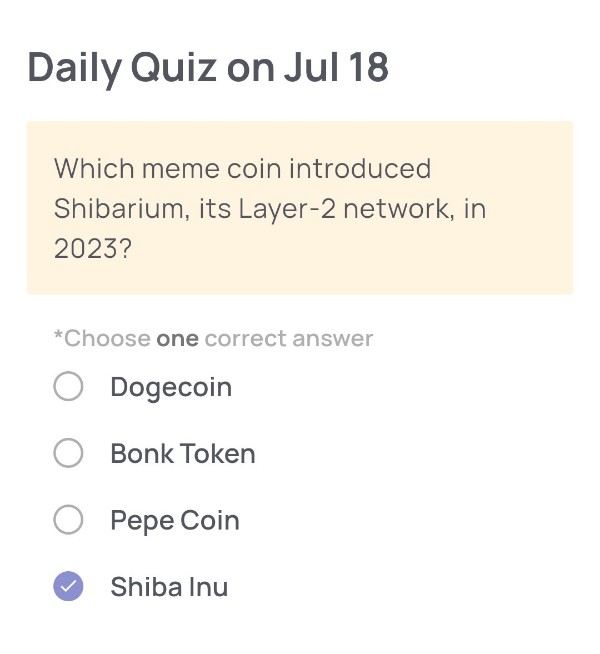
🟢Quiz Questions:
Which meme coin introduced Shibarium, its Layer-2 network, in 2023?
🟢Choose one correct answer:
・Dogecoin
・Bonk Token
・Pepe Coin
・Shiba Inu
🟢Answer:
Shiba Inu
🟢Reason for choosing this answer:
Shiba Inu launched Shibarium in 2023 as a Layer-2 blockchain solution built on Ethereum. Its purpose is to improve scalability, reduce gas fees, and enhance transaction speed within the Shiba Inu ecosystem. None of the other meme coins listed have introduced a Layer-2 network like Shibarium.
🟢Trivia:
Shibarium isn’t just for SHIB transactions — it also integrates other tokens in the Shiba Inu ecosystem like BONE and LEASH. As part of its launch, the developers emphasized building real utility and expanding beyond meme status, aiming to develop a decentralized ecosystem with DeFi, NFTs, and gaming applications.
Daily Quiz on JULY 17
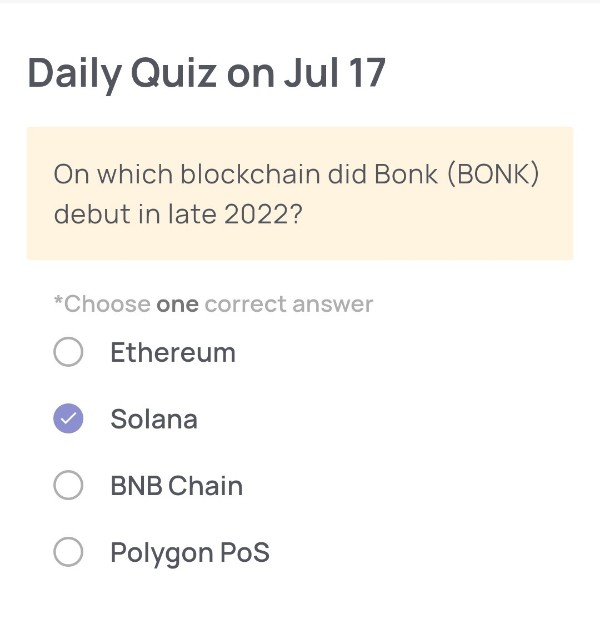
🟢 Quiz Questions:
On which blockchain did Bonk (BONK) debut in late 2022?
🟢 Choose one correct answer:
・Ethereum
・Solana
・BNB Chain
・Polygon PoS
🟢 Answer:
Solana
🟢 Reason for choosing this answer:
Bonk (BONK) was launched on December 25, 2022, as Solana’s first dog-themed meme coin. It debuted via a large-scale airdrop to Solana community members—developers, NFT holders, and users—and trading began just days later, on December 30, 2022.
🟢 Trivia:
・BONK’s airdrop distributed 50% of its total 100 trillion supply directly to the Solana community—unprecedented generosity that generated widespread enthusiasm.
・Bonk quickly became a flagship meme token integrated across hundreds of Solana dApps, including DEXs, NFT platforms, and even payment tools like BonkBot.
・The surge in BONK trading volume in early 2023 helped reinvigorate activity on Solana—its debut even pushed SOL’s price up ~34% over 48 hours.
Daily Quiz on JULY 16
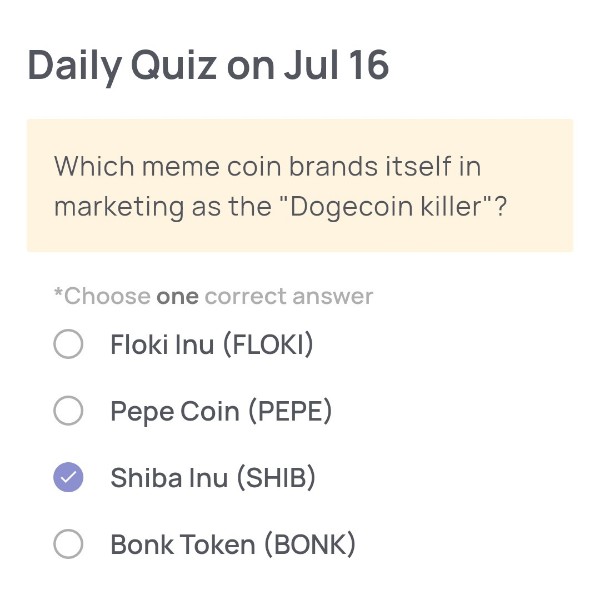
🟢Quiz Questions:
Which meme coin brands itself in marketing as the “Dogecoin killer”?
🟢Choose one correct answer:
・Floki Inu (FLOKI)
・Pepe Coin (PEPE)
・Shiba Inu (SHIB)
・Bonk Token (BONK)
🟢Answer:
Shiba Inu (SHIB)
🟢Reason for choosing this answer:
Shiba Inu (SHIB) has famously branded itself as the “Dogecoin killer” since its inception. This label is part of its aggressive marketing strategy, aiming to surpass Dogecoin (DOGE) in popularity and utility within the meme coin space. The project’s whitepaper—referred to as a “woof paper”—specifically emphasizes its goal of outperforming Dogecoin in community strength and ecosystem development.
🟢Trivia:
Shiba Inu was launched in August 2020 by an anonymous creator named “Ryoshi.” Despite its meme status, SHIB has built an entire ecosystem including a decentralized exchange (ShibaSwap), NFT projects, and plans for its own blockchain called “Shibarium.” The token gained massive popularity in 2021 during the meme coin frenzy and has since become one of the top meme tokens by market cap.
Daily Quiz on JULY 15
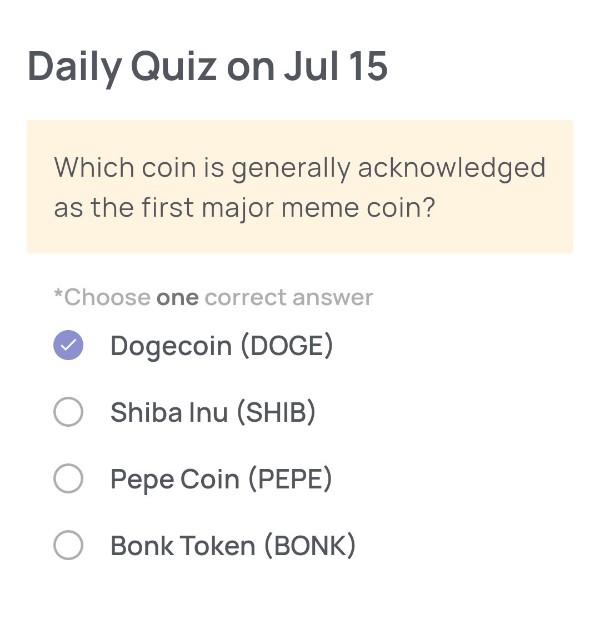
🟢Quiz Questions:
Which coin is generally acknowledged as the first major meme coin?
🟢Choose one correct answer:
・Dogecoin (DOGE)
・Shiba Inu (SHIB)
・Pepe Coin (PEPE)
・Bonk Token (BONK)
🟢Answer:
Dogecoin (DOGE)
🟢Reason for choosing this answer:
Dogecoin (DOGE) is widely recognized as the first major meme coin. It was launched in December 2013 as a joke based on the popular “Doge” meme featuring a Shiba Inu dog. Despite its humorous beginnings, Dogecoin quickly gained a strong community and became known for tipping content creators online. It predates Shiba Inu (2020), PEPE (2023), and BONK (2022), establishing it as the original and most iconic meme coin.
🟢Trivia:
Dogecoin was co-created by software engineers Billy Markus and Jackson Palmer. Although it started as a parody, Dogecoin has been used in notable charitable events and sponsorships, including funding the Jamaican bobsled team and sponsoring NASCAR driver Josh Wise. Elon Musk’s tweets have also significantly impacted DOGE’s price, further popularizing the coin.
Daily Quiz on JULY 14
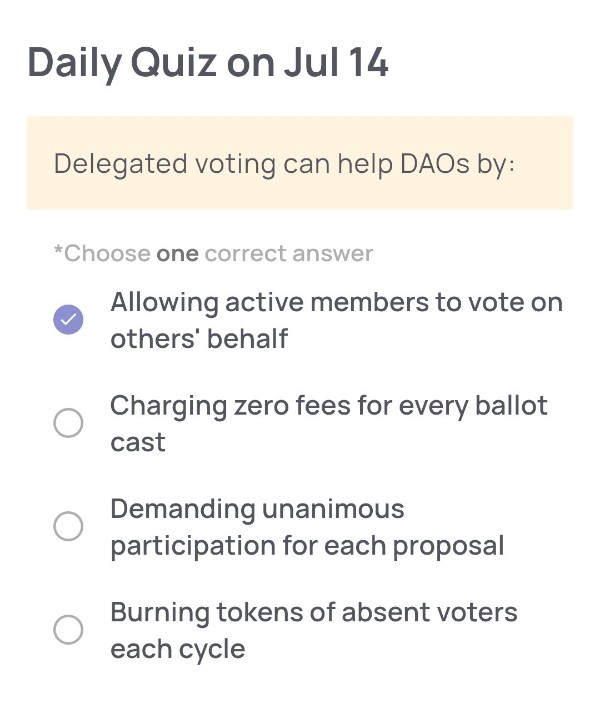
🟢Quiz Questions:
Delegated voting can help DAOs by:
🟢Choose one correct answer:
・Allowing active members to vote on others’ behalf
・Charging zero fees for every ballot cast
・Demanding unanimous participation for each proposal
・Burning tokens of absent voters each cycle
🟢Answer:
Allowing active members to vote on others’ behalf
🟢Reason for choosing this answer:
Delegated voting (also known as “liquid democracy”) enables participants in a DAO (Decentralized Autonomous Organization) to delegate their voting power to more active or knowledgeable members. This approach enhances participation and decision-making efficiency, especially in large communities where not everyone can or wants to vote on every proposal. It helps overcome voter apathy and ensures that informed voices still influence the outcomes, maintaining the DAO’s democratic integrity.
🟢Trivia:
In Xenea’s Proof of Democracy (PoD) model, a similar concept is applied. Xenea Wallet users can delegate their voting rights to Rep Nodes, which then exercise that voting power on their behalf. When these Rep Nodes successfully participate in consensus, rewards are distributed back to the users who delegated their votes. This design supports scalability and broad participation without compromising on security or decentralization.
Daily Quiz on JULY 13
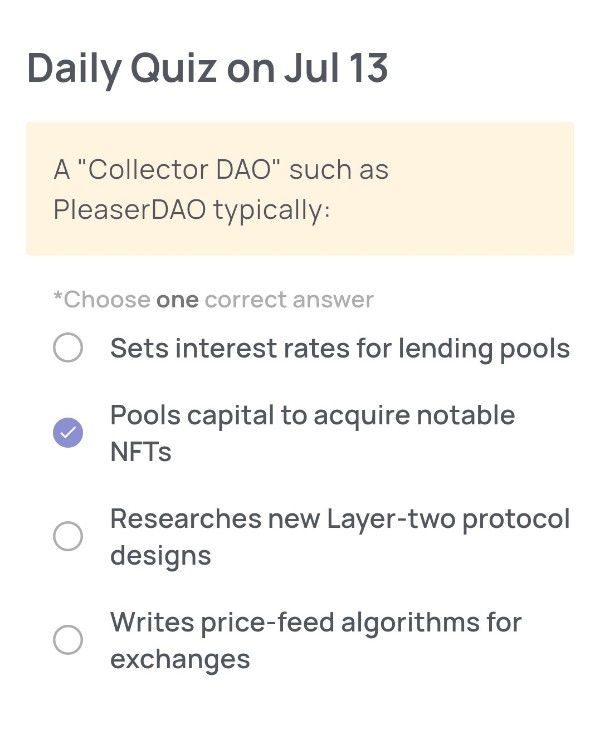
🟢 Quiz Questions:
A “Collector DAO” such as Pleaser DAO typically:
🟢 Choose one correct answer:
・Sets interest rates for lending pools
・Pools capital to acquire notable NFTS
・Researches new Layer-two protocol designs
・Writes price-feed algorithms for exchanges
🟢 Answer:
Pools capital to acquire notable NFTS
🟢 Reason for choosing this answer:
A “Collector DAO” like PleaserDAO is known for pooling funds from its members to acquire culturally significant or notable NFTs. These DAOs are community-governed organizations focused on collecting and curating digital art or other tokenized assets, rather than providing lending services or developing technical infrastructure like Layer 2s or pricing oracles.
🟢 Trivia:
PleaserDAO gained attention after acquiring the original “Doge” meme NFT for approximately $4 million. These DAOs are part of a growing trend where decentralized communities collaboratively own and manage high-value digital assets, reflecting a new form of collective digital ownership in the Web3 space.
Daily Quiz on JULY 12
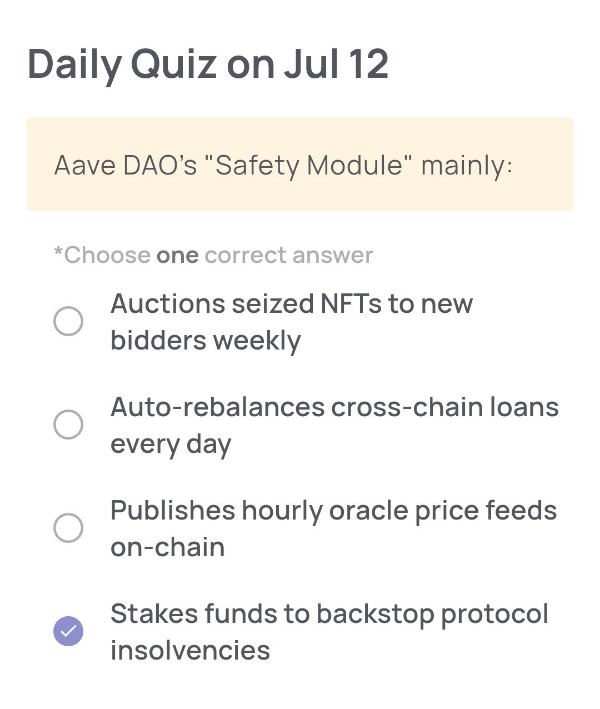
🟢 Quiz Questions:
Aave DAO’s “Safety Module” mainly:
🟢Choose one correct answer:
・Auctions seized NFTs to new bidders weekly
・Auto-rebalances cross-chain loans every day
・Publishes hourly oracle price feeds on-chain
・Stakes funds to backstop protocol insolvencies
🟢 Answer:
Stakes funds to backstop protocol insolvencies
🟢 Reason for choosing this answer:
The Aave Safety Module is designed as a risk buffer mechanism where users stake AAVE (or, under the newer Umbrella upgrade, aTokens) to provide funds that can be slashed and used to cover deficits resulting from bad debt or insolvency within the protocol . In essence, it acts like an insurance fund that protects the protocol’s solvency.
🟢Trivia:
Evolution into Umbrella: In June 2025, Aave upgraded its Safety Module into a system called Umbrella, which allows users to stake yield-bearing aTokens (like aUSDC, aUSDT, aWETH, GHO), offering more efficient and asset-specific coverage against bad debt.
Automated slashing: Umbrella automates the slashing process—when a deficit crosses a defined threshold, the relevant staked tokens are burned automatically without requiring governance votes.
Capital efficiency: By staking aTokens directly tied to the asset at risk, the system avoids unnecessary liquidations of AAVE tokens and reduces pressure on AAVE’s market.
Daily Quiz on JULY 11
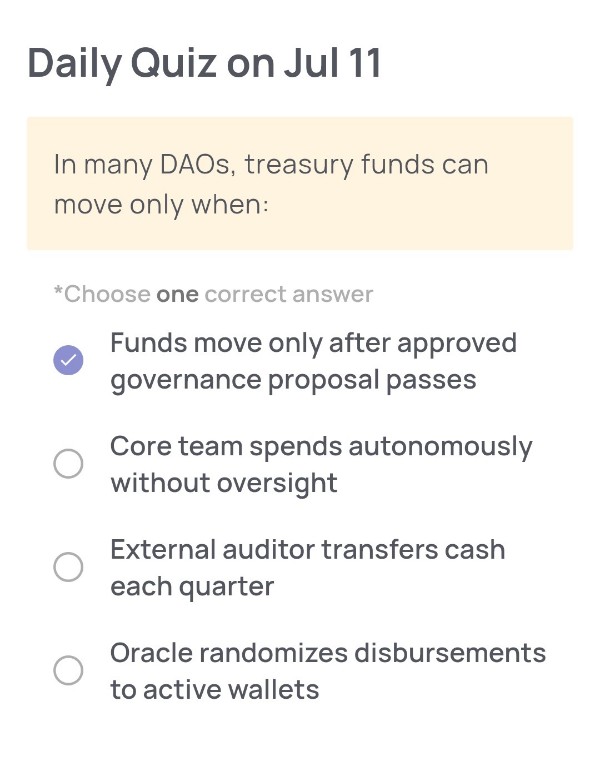
🟢Quiz Questions:
In many DAOs, treasury funds can move only when:
🟢Choose one correct answer:
・Funds move only after approved governance proposal passes
・Core team spends autonomously without oversight
・External auditor transfers cash each quarter
・Oracle randomizes disbursements to active wallets
🟢Answer:
Funds move only after approved governance proposal passes
🟢Reason for choosing this answer:
In Decentralized Autonomous Organizations (DAOs), the movement of treasury funds typically follows a governance structure. This means funds are not moved arbitrarily but rather only after the community approves a proposal through voting. This democratic approach ensures transparency and accountability, which are core principles of DAOs.
🟢Trivia:
The governance process in many DAOs is powered by governance tokens. Token holders use these tokens to vote on proposals, which may include funding allocations, development priorities, or protocol upgrades. One notable example is MakerDAO, where MKR token holders vote on risk parameters and the use of the DAO’s DAI stablecoin reserves.
Daily Quiz on JULY 10
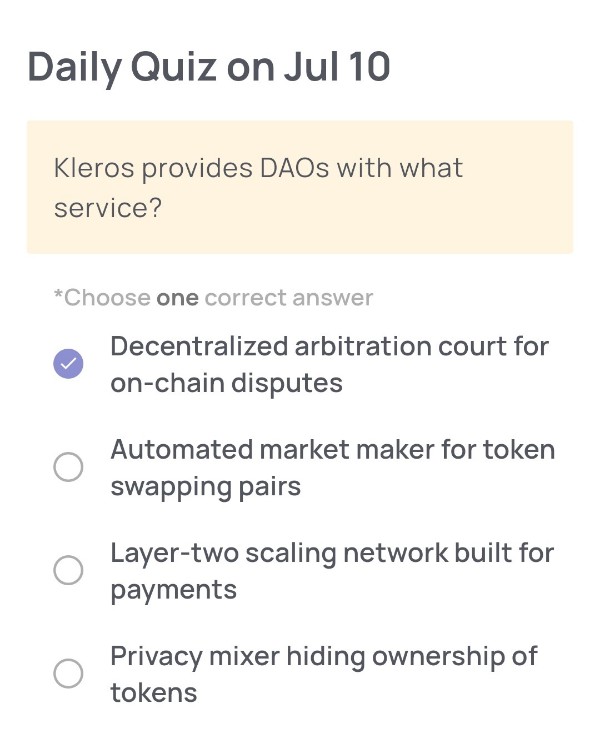
🟢Quiz Questions:
Kleros provides DAOs with what service?
🟢Choose one correct answer:
・Decentralized arbitration court for on-chain disputes
・Automated market maker for token swapping pairs
・Layer-two scaling network built for payments
・Privacy mixer hiding ownership of tokens
🟢Answer:
Decentralized arbitration court for on-chain disputes
🟢Reason for choosing this answer:
Kleros is known for providing a decentralized arbitration service, which allows DAOs and other blockchain projects to resolve disputes through crowdsourced jurors. These jurors are incentivized to rule fairly and are randomly selected from the community. It operates as a blockchain-based court system, ensuring transparency and minimizing bias in on-chain dispute resolution.
🟢Trivia:
Kleros uses a concept called “cryptoeconomic incentive” where jurors stake a token called PNK (Pinakion). Jurors who vote with the majority are rewarded, while those who vote differently may lose their stake. This system encourages fairness and discourages collusion or manipulation, making it a novel approach to decentralized justice.
Daily Quiz on JULY 9
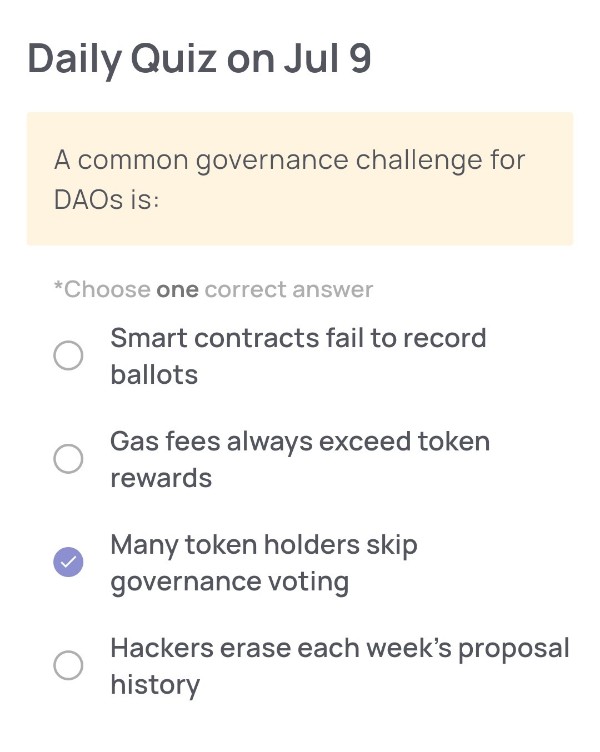
🟢Quiz Questions:
A common governance challenge for DAOs is:
🟢Choose one correct answer:
・Smart contracts fail to record ballots
・Gas fees always exceed token rewards
・Many token holders skip governance voting
・Hackers erase each week’s proposal history
🟢Answer:
Many token holders skip governance voting
🟢Reason for choosing this answer:
A well-known and persistent challenge in DAO (Decentralized Autonomous Organization) governance is voter apathy — where many token holders, despite having the right to vote, choose not to participate in governance decisions. This results in low voter turnout, skewed decision-making, and underrepresentation of the broader community’s interests. The issue is not typically due to technical failures like smart contract errors or hackers erasing proposals, but rather human behavior — a lack of incentive, interest, or understanding about proposals.
🟢Trivia:
Some DAOs have introduced delegated voting systems where token holders can assign their voting power to trusted representatives (delegates) who actively participate. Others offer token rewards or reputation points to incentivize governance participation. Projects like MakerDAO and Compound are examples of DAOs that have adopted such models to combat governance apathy.
Daily Quiz on JULY 8
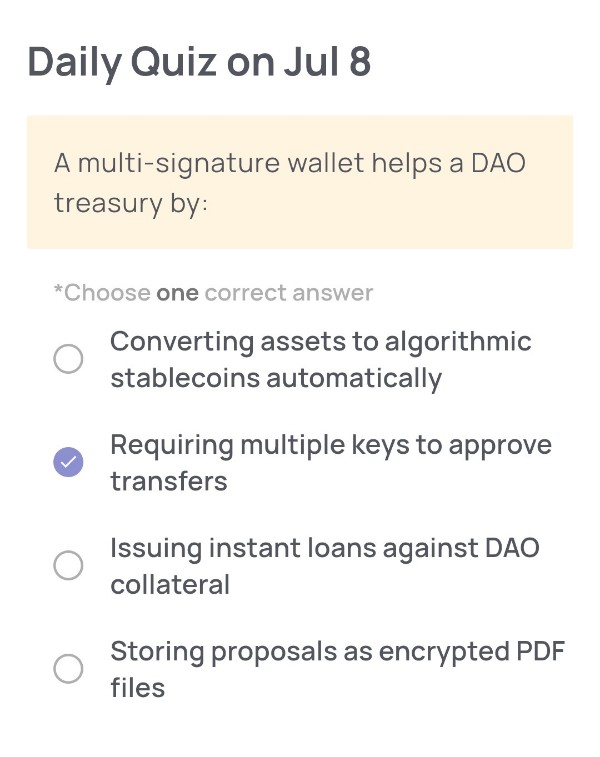
🟢Quiz Questions:
A multi-signature wallet helps a DAO treasury by:
🟢Choose one correct answer:
・Converting assets to algorithmic stablecoins automatically
・Requiring multiple keys to approve transfers
・Issuing instant loans against DAO collateral
・Storing proposals as encrypted PDF files
🟢Answer:
Requiring multiple keys to approve transfers
🟢Reason for choosing this answer:
A multi-signature (multi-sig) wallet is designed to enhance the security and integrity of a DAO (Decentralized Autonomous Organization) treasury. It requires a predetermined number of private keys—held by different stakeholders—to approve any transaction. This prevents a single entity from unilaterally moving funds, reducing the risk of theft or misuse and promoting collective governance.
🟢Trivia:
Multi-signature wallets are commonly used in DAOs and corporate crypto treasuries to enforce checks and balances. For example, a 3-of-5 multi-sig requires at least three out of five authorized signers to approve a transaction before it’s executed. This mechanism increases trust among participants and is often a prerequisite for managing community or investment funds in decentralized environments.
Daily Quiz on JULY 7

🟢Quiz Questions:
DAO voting power is most often based on:
*Choose one correct answer
・Wallet creation date on-chain
・Total forum posts written weekly
・Physical signatures collected at events
・Number of governance tokens held
🟢Answer:
Number of governance tokens held
🟢Reason for choosing this answer:
In most DAOs (Decentralized Autonomous Organizations), voting power is directly proportional to the number of governance tokens a member holds. These tokens represent voting rights, allowing holders to propose and vote on changes. The more tokens you have, the greater your influence—this is a fundamental mechanism of token-based governance.
🟢Trivia:
This model is often criticized for creating a “wealth equals power” structure, which can lead to centralization. To counter this, some DAOs implement quadratic voting or reputation-based systems to balance influence. An example of DAO governance is MakerDAO, where MKR token holders vote on risk parameters and protocol upgrades.
Daily Quiz on JULY 6
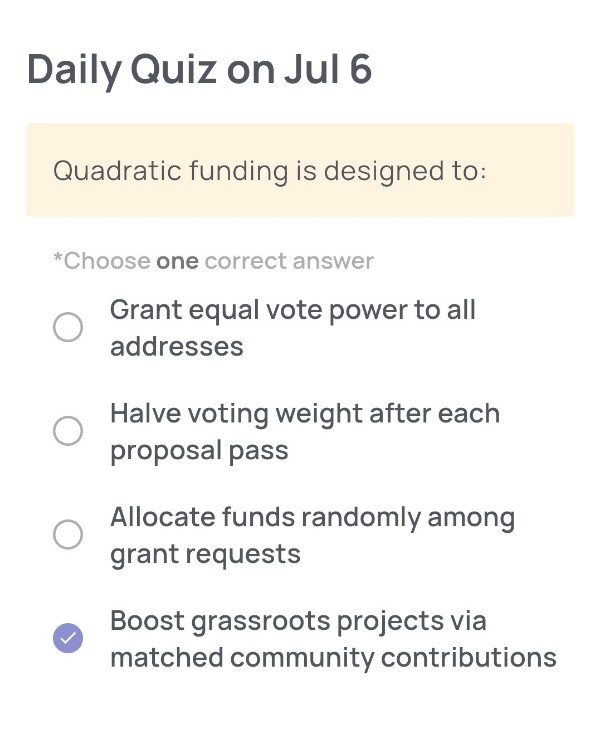
🟢Quiz Questions:
Quadratic funding is designed to:
🟢Choose one correct answer:
・Grant equal vote power to all addresses
・Halve voting weight after each proposal pass
・Allocate funds randomly among grant requests
・Boost grassroots projects via matched community contributions
🟢Answer:
Boost grassroots projects via matched community contributions
🟢Reason for choosing this answer:
Quadratic funding is a democratic funding mechanism that encourages community-driven support for public goods. It works by matching individual contributions using a formula that favors broad, smaller donations over large ones from a few individuals. This ensures that projects with widespread grassroots support receive more matched funding, amplifying the voice of the community and making the funding process more equitable and decentralized.
🟢Trivia:
The quadratic funding model was first proposed by Vitalik Buterin (Ethereum), Glen Weyl, and Zoë Hitzig. It has been used by platforms like Gitcoin to fund open-source software and community initiatives, showing real-world success in transparent, community-oriented funding allocation.
Daily Quiz on JULY 5
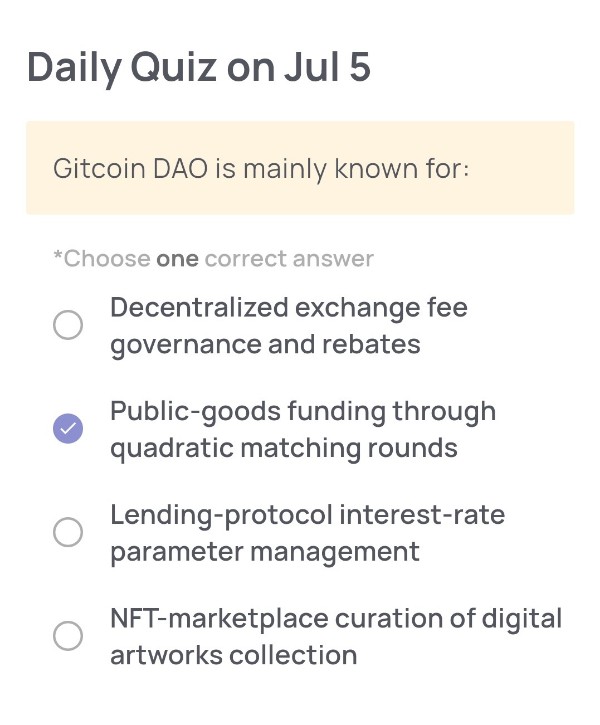
🟢Quiz Questions:
Gitcoin DAO is mainly known for:
🟢Choose one correct answer:
・Decentralized exchange fee governance and rebates
・Public-goods funding through quadratic matching rounds
・Lending-protocol interest-rate parameter management
・NFT-marketplace curation of digital artworks collection
🟢Answer:
Public-goods funding through quadratic matching rounds
🟢Reason for choosing this answer:
Gitcoin DAO is best known for its role in funding public goods using a mechanism called quadratic funding. This approach amplifies the impact of small individual donations to projects that are widely supported by the community, effectively promoting grassroots projects. Gitcoin has hosted multiple rounds of this matching-based funding to support open-source software and other public-benefit projects, establishing itself as a cornerstone in the Web3 ecosystem for democratic, community-led funding.
🟢Trivia:
Quadratic funding was co-developed by Vitalik Buterin (Ethereum co-founder) and is considered one of the most promising models for democratic allocation of resources. In Gitcoin’s system, the more contributors a project has, the more matching funds it receives—rewarding community interest rather than just the size of individual donations.
Daily Quiz on JULY 4
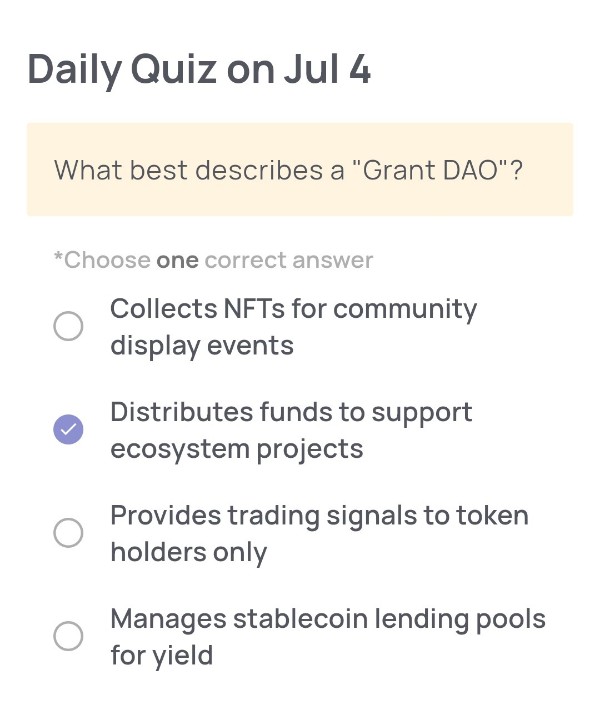
🟢Quiz Questions:
What best describes a “Grant DAO”?
🟢Choose one correct answer:
・Collects NFTs for community display events
・Distributes funds to support ecosystem projects
・Provides trading signals to token holders only
・Manages stablecoin lending pools for yield
🟢Answer:
Distributes funds to support ecosystem projects
🟢Reason for choosing this answer:
A “Grant DAO” is a decentralized autonomous organization focused on funding initiatives that enhance and grow a blockchain ecosystem. It typically allocates capital—often in the form of native tokens or stablecoins—to developers, projects, or contributors who apply for funding through community governance. This structure ensures transparency, decentralization, and community-driven support for innovation.
🟢Trivia:
One famous example of a Grant DAO is Gitcoin Grants, which supports open-source software projects through quadratic funding—a model that favors projects with broad community support over those with a few wealthy backers. Grant DAOs play a vital role in Web3 by distributing resources in a democratic and transparent manner.
Daily Quiz on JULY 3
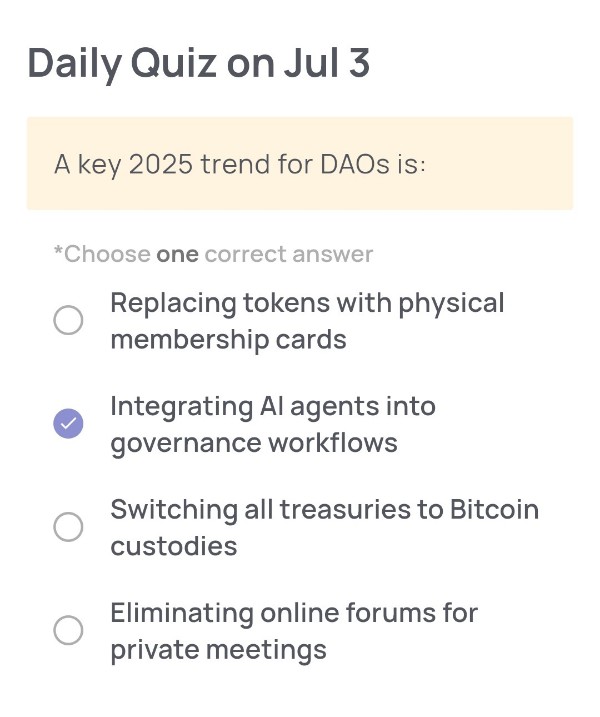
🟢Quiz Questions:
A key 2025 trend for DAOs is:
🟢Choose one correct answer:
・Replacing tokens with physical membership cards
・Integrating AI agents into governance workflows
・Switching all treasuries to Bitcoin custodies
・Eliminating online forums for private meetings
🟢Answer:
Integrating AI agents into governance workflows
🟢Reason for choosing this answer:
In 2025, a notable trend within DAOs (Decentralized Autonomous Organizations) is the incorporation of AI agents to optimize governance. These agents help automate complex decision-making, analyze large datasets for proposals, and enhance operational efficiency. This shift reflects the growing synergy between decentralized infrastructure and AI technologies, as seen in recent collaborations like the one between Xenea and Perceptron Network, which aims to link decentralized data with AI agent systems.
🟢Trivia:
The integration of AI into DAOs represents a broader Web3 trend toward “decentralized intelligence.” Projects like Perceptron Network create economies where AI agents grow through community interaction, issuing NFT-based rewards. These agents can autonomously participate in governance, providing informed decisions that are stored securely on decentralized storage like Xenea’s DACS. This approach enables new types of DAO participation and governance, enhancing scalability and trust.
Daily Quiz on JULY 2
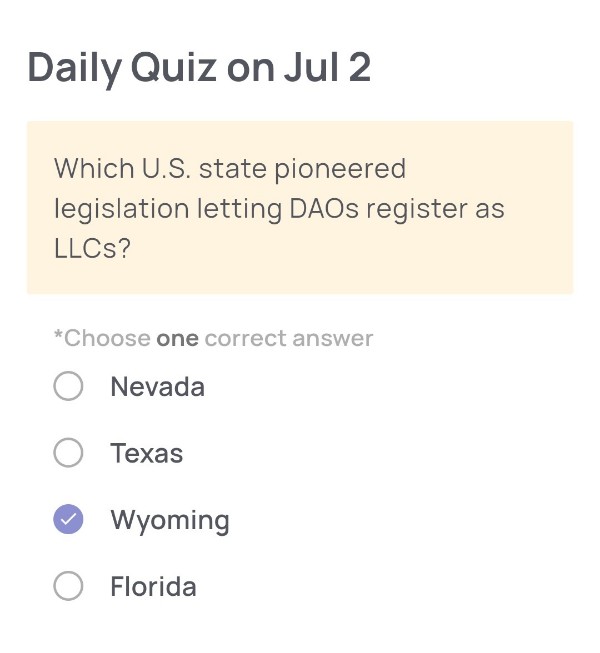
🟢Quiz Questions:
Which U.S. state pioneered legislation letting DAOs register as LLCs?
🟢Choose one correct answer:
・Nevada
・Texas
・Wyoming
・Florida
🟢Answer:
Wyoming
🟢Reason for choosing this answer:
Wyoming became the first U.S. state to pass a law in July 2021 (Wyoming’s Senate Bill 38) allowing DAOs to register as decentralized autonomous organization LLCs—granting legal personhood and limited liability status under state law.
🟢Trivia:
・Wyoming isn’t new to business innovation—it was also the first state in 1977 to pioneer the LLC structure itself.
・Under Wyoming’s DAO LLC law, a DAO can be “member‑managed” or “algorithmically managed,” must disclose its smart contract address, and faces automatic dissolution if it remains inactive for a year.
Daily Quiz on JULY 1
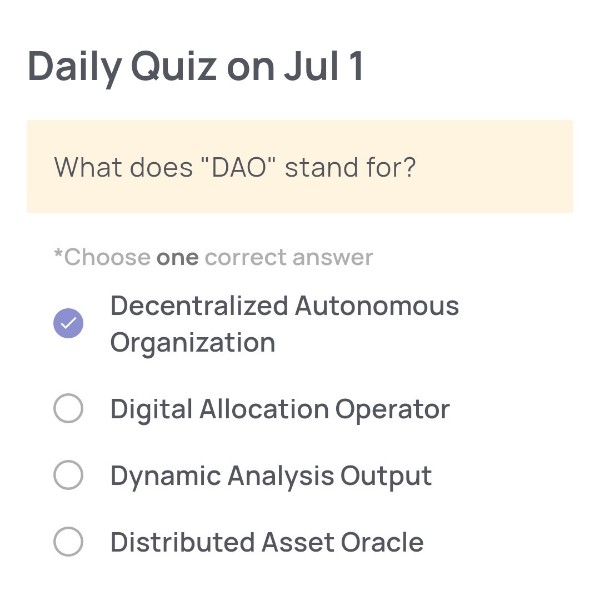
🟢Quiz Questions:
What does “DAO” stand for?
🟢Choose one correct answer:
・Decentralized Autonomous Organization
・Digital Allocation Operator
・Dynamic Analysis Output
・Distributed Asset Oracle
🟢Answer:
Decentralized Autonomous Organization
🟢Reason for choosing this answer:
“DAO” stands for “Decentralized Autonomous Organization.” This term refers to an organization represented by rules encoded as a computer program that is transparent, controlled by organization members and not influenced by a central government. DAOs are designed to be automated and decentralized, often running on blockchain platforms such as Ethereum.
🟢Trivia:
DAOs enable global collaboration without the need for traditional corporate structures. One of the first well-known DAOs was “The DAO” on Ethereum in 2016, which raised over $150 million in Ether but was famously hacked due to a vulnerability in its code, leading to a significant fork in the Ethereum blockchain.
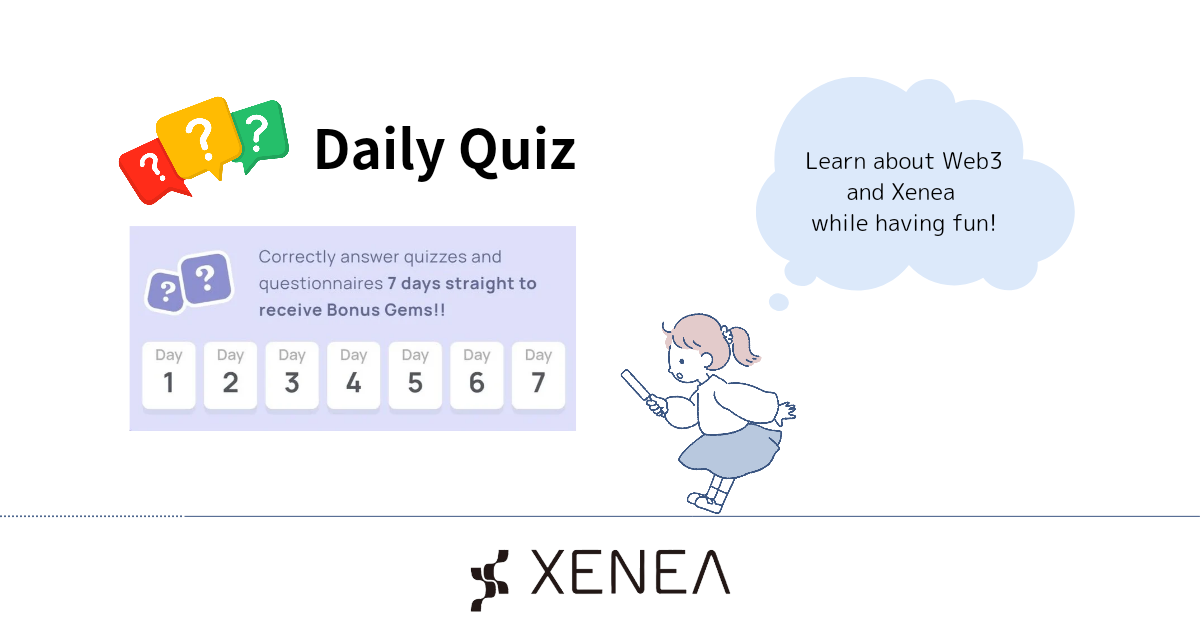
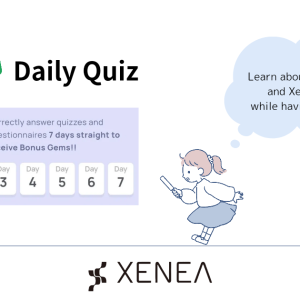
Comment